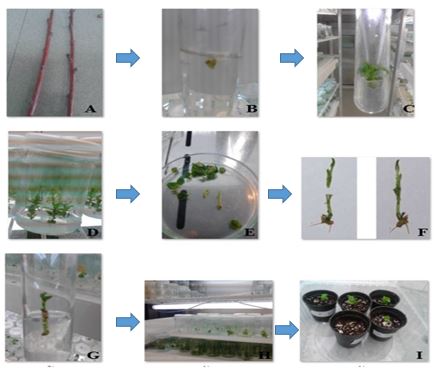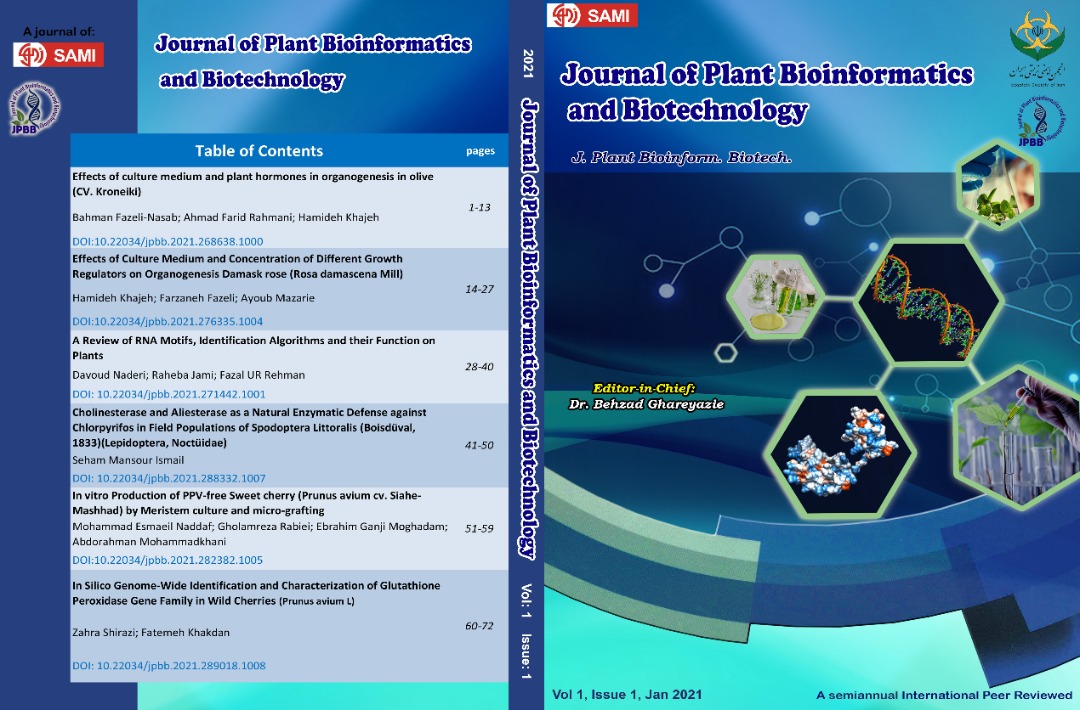1. FAO. (2018). Http: //faostat.fao.org/faostat.
2. Ganji moghadam E, Buzari N. (2007). Practical and Practical Guide to Sweet cherry. Tehran, Iran: Agricultural Extension Education and Extensions Press. 344 Pages,
3. Fazeli-Nasab B, Naghavi M R. (2011). Identification of Rust resistance among wheat cultiras using SSRs markers. Journal of Agronomy Science, 4(5): 81-88.
4. Boxus P, Druart P. (1986). Virus-free trees through tissue culture Trees I (pp. 24-30): Springer. https://doi.org/10.1007/978-3-642-70576-2_2
5. Acero N, Gradillas A, Beltran M, García A, Mingarro D M. (2019). Comparison of phenolic compounds profile and antioxidant properties of different sweet cherry (Prunus avium L.) varieties. Food chemistry, 279: 260-271. https://doi.org/10.1016/j.foodchem.2018.12.008
6. Domínguez-Rodríguez G, Marina M L, Plaza M. (2021). Enzyme-assisted extraction of bioactive non-extractable polyphenols from sweet cherry (Prunus avium L.) pomace. Food chemistry, 339: 128086. https://doi.org/10.1016/j.foodchem.2020.128086
7. Mehrabi A-A, Fazeli-Nasab B. (2012). In vitro culture of Allium scorodoprasum spp. Rotundum: callus induction, somatic embryogenesis and direct bulblet formation. Intl. J. Agri. Crop Sci, 4(1): 1-7.
8. Hussain G, Wani M, Mir M, Rather Z, Bhat K. (2014). Micrografting for fruit crop improvement. African Journal of Biotechnology, 13(25). https://doi.org/10.5897/AJB2013.13602
9. Jonard R. (1986). Micrografting and its applications to tree improvement Trees I (pp. 31-48): Springer. https://doi.org/10.1007/978-3-642-70576-2_3
10. Sobhanizadeh A, Solouki M, Fazeli-Nasab B. (2017). Optimization of callus induction and effects of biological and non-biological elicitors on content of phenol/flavonoid compounds in Nigella sativa under in-vitro conditions. Journal of Cell & Tissue, 8(2): 165-184. https://doi.org/10.29252/JCT.8.2.165
11. Manganaris G A, Economou A S, Boubourakas I, Katis N I. (2003). Elimination of PPV and PNRSV through thermotherapy and meristem-tip culture in nectarine. Plant Cell Reports, 22(3): 195-200. https://doi.org/10.1007/s00299-003-0681-y
12. Dessoky E S, Attia O, Ismail A I, El-Sharnouby M. (2018). Production of Virus-Free Peach (Prunus persica L. Batsch) Plants cv. Balady Grown in Taif, by Meristem Culture and Thermotherapy. BIOSCIENCE RESEARCH, 15(1): 124-132.
13. Koubouris G C, Maliogka V I, Efthimiou K, Katis N I, Vasilakakis M D. (2007). Elimination of Plum pox virus through in vitro thermotherapy and shoot tip culture compared to conventional heat treatment in apricot cultivar Bebecou. Journal of general plant pathology, 73(5): 370-373. https://doi.org/10.1007/s10327-007-0028-6
14. Singh K, Neubauerová T, Kundu J K. (2019). Quantitative analysis of the interaction of heterologous viruses with Plum pox virus in C5 HoneySweet transgenic plums. Journal of Integrative Agriculture, 18(10): 2302-2310. https://doi.org/10.1016/S2095-3119(18)62136-7
15. Singh B, Sharma S, Rani G, Hallan V, Zaidi A, Virk G, Nagpal A. (2008). In vitro micrografting for production of Indian citrus ringspot virus (ICRSV)-free plants of kinnow mandarin (Citrus nobilis Lour× C. deliciosa Tenora). Plant Biotechnology Reports, 2(2): 137-143. https://doi.org/10.1007/s11816-008-0055-6
16. Abbas M, Khan M, Fatima B, Iftikhar Y, Mughal S, Jaskani M, Khan I, Abbas H. (2008). Elimination of Citrus tristeza closterovirus (ctv) and production of certified citrus plants through shoot-tip micrografting. Pak. J. Bot, 40(3): 1301-1312.
17. Jin S B, Park J H, Park S M, Lee D H, Yun S H. (2017). Production of Citrus plants from ovule cell culture and verification of CTV-free plants. Horticultural Science & Technology, 35(1): 121-130. https://doi.org/10.12972/kjhst.20170013
18. Zhao D, Song G q. (2014). Rootstock-to-scion transfer of transgene‐derived small interfering RNA s and their effect on virus resistance in nontransgenic sweet cherry. Plant biotechnology journal, 12(9): 1319-1328. https://doi.org/10.1111/pbi.12243
19. Çelik A, Ertunç F. (2019). First report of prunus necrotic ringspot virus infecting apple in Turkey. Journal of Plant Pathology, 101(4): 1227-1227. https://doi.org/10.1007/s42161-019-00286-7
20. Sabbadini S, Ricci A, Limera C, Baldoni D, Capriotti L, Mezzetti B. (2019). Factors affecting the regeneration, via organogenesis, and the selection of transgenic calli in the peach rootstock Hansen 536 (Prunus persica× Prunus amygdalus) to express an RNAi construct against PPV virus. Plants, 8(6): 178. https://doi.org/10.3390/plants8060178
21. Hu C, Wang P. (1983). Meristem, shoot tip and bud cultures. Handbook of plant cell culture (USA).
22. Hu G j, Dong Y f, Zhang Z p, Fan X d, Ren F, Li Z n. (2017). Efficacy of virus elimination from apple by thermotherapy coupled with in vivo shoot-tip grafting and in vitro meristem culture. Journal of Phytopathology, 165(10): 701-706. https://doi.org/10.1111/jph.12610
23. Murashige T, Skoog F. (1962). A revised medium for rapid growth and bio assays with tobacco tissue cultures. Physiologia plantarum, 15(3): 473-497.
24. Dijkstra J, de Jager C. (2012). Practical plant virology: protocols and exercises: Springer Science & Business Media. 459 pages,
25. Sauer A. (1984). In vitro propagation of Prunus avium L. and storage of in vitro derived plantlets. Paper presented at the International Workshop on Improvement of Sweet and Sour Cherry Varieties and Rootstocks 169. https://doi.org/10.17660/ActaHortic.1985.169.48
26. Amiri M E. (2006). In vitro techniques to study the shoot-tip grafting of Prunus avium L.(cherry) var. Seeyahe Mashad. Journal of Food, Agriculture & Environment, 41: 151-154.
27. Martinez J, Hugard J, Jonard R. (1978). The different grafting of shoot-tips realized in vitro between peach (Prunus persica, Batsch), apricot (Prunus armeniaca, L.) and myrobolan (Prunus cesarifera, Ehrh). Comptes Rendus Hebdomadaires des Seances de l'Academie des Sciences. Serie D, 288: 759-762.
28. Lauri P, Caboni E, Damiano C. (2000). In vitro adventitious shoot regeneration from vegetative apices of almond and other Prunus species. Paper presented at the IV International Symposium on In Vitro Culture and Horticultural Breeding 560. https://doi.org/10.17660/ActaHortic.2001.560.77


